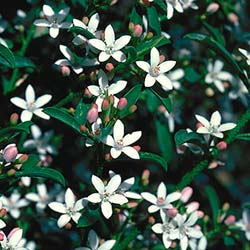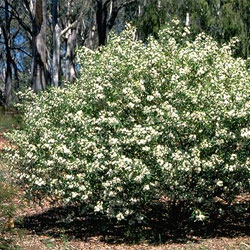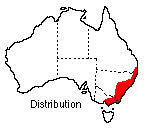Philotheca myoporoides
 |
 |
(synonym Eriostemon myoporoides)
Long-leaf Waxflower
Philotheca myoporoides (DC.) Bayly
The Long-leaf Waxflower (Philotheca myoporoides) of Queensland, New South Wales and Victoria, is a hardy large shrub with a long flowering season of small but showy pale flowers set amid a firm mid-green foliage. It is a hardy plant that will thrive through cold and drought. It is often wider than its height and is very dense in growth right down to ground level. It anchors well and, as the branches are flexible and tough, is not liable to breakage in strong winds.

The narrow leaves are of a slightly waxy appearance up to 8 cm long and held out at a wide angle from the stem in an open, alternate arrangement. In the axils of each are heads of the flowers in groups of from three to five buds, well held out on one centimetre-long stems, even when only a few are open. Buds of apple-blossom pink open to flat, starry flowers with five white petals. The flowers are no more than 2 centimetres across but show out well against the green foliage. In Canberra the first buds open about the end of June, gradually increasing through the winter depending on the season - until early September when the shrub will be dotted with flowers. Best months are usually October and November when flowering is profuse down to ground level. Odd flowers may appear in summer and autumn.
The shrub is available from nurseries and can be raised from cuttings struck indoors under glass, or outside in the shade, depending on the season. After 12 months the plant should be ready to plant out from its pot and may be located in almost any position in the garden, either in the sun or semi-shade. lt seems to succeed in either heavy or light soil and will respond to light dressings of blood and bone in the growing season. If dense plants are required it can be lightly pruned, and used for an informal hedge.
If smut fungus - a black, sooty covering of the leaves-appears it can be washed off with cotton wool and water or alternatively can be treated with white oil. Sprigs of flowers can be used indoors but branches will not keep fresh and buds will not open. The Philothecas belong to a large plant family, Rutaceae, which includes the citrus trees and many small decorative native shrubs. Boronias, Eriostemons, Croweas and Phebaliums all have garden potential.
Based on text by Irene Beeton (1971)
Name meaning: Philotheca myoporoidesPhilotheca; philos - loving; theke - a covering or box. Allusion unclear but referring to the seed capsule; myoporoides - resembling the genus Myoporum |
![An Australian Government Initiative [logo]](/images/austgovt_brown_90px.gif)

